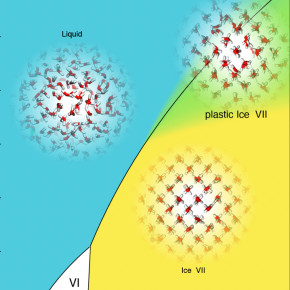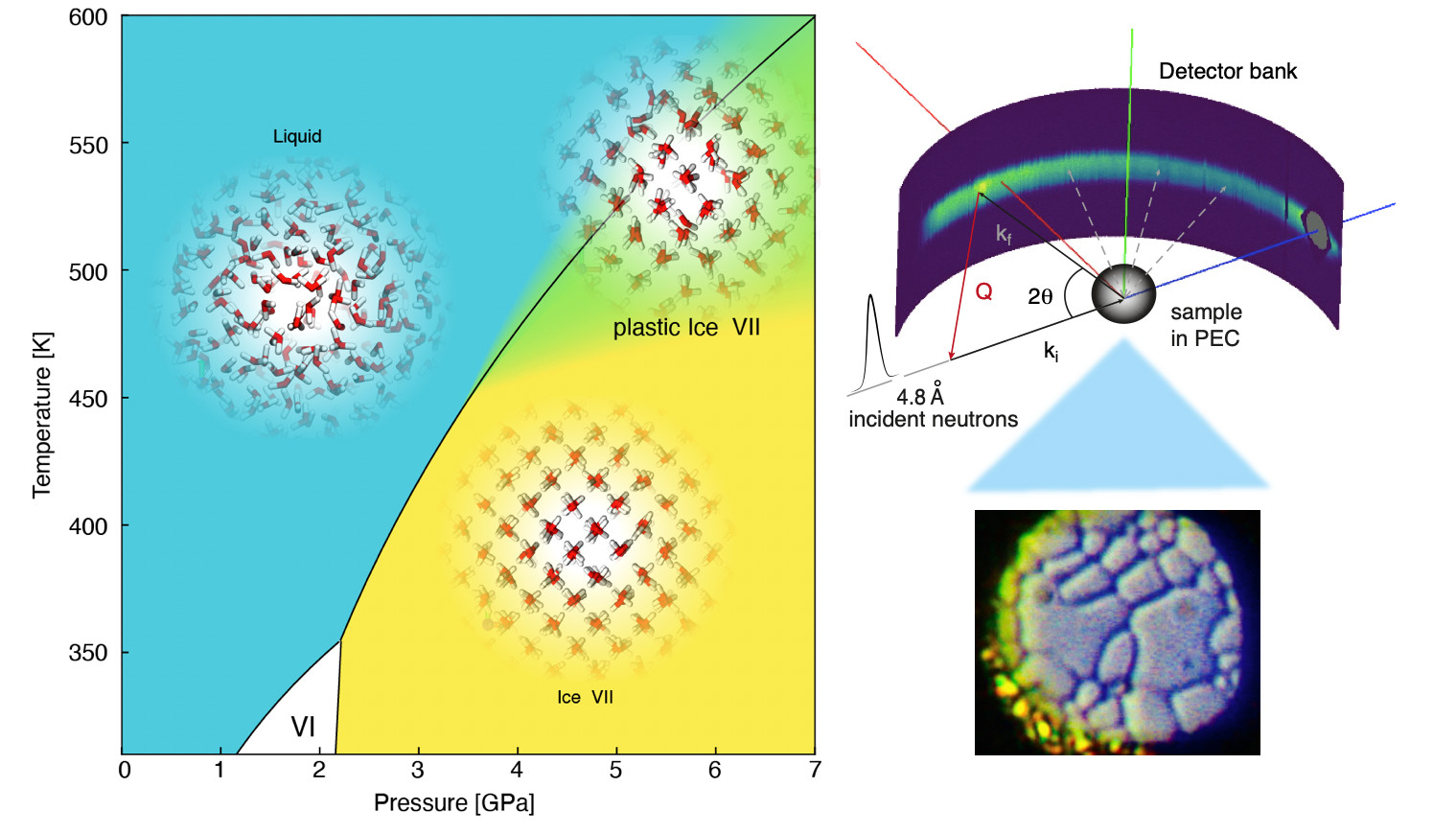A wide international collaboration of scientists gathered around the IN5B time-of-flight neutron spectrometer at ILL, has observed for the first time an exotic phase of water ice, where molecules organize themselves into cubic crystals, freezing all translational motion, while retaining the freedom to rotate on themselves. This “plastic” ice can be observed at very high pressures (5 GPa) and temperatures between 200 and 350°C, conditions found at the bottom of the oceans of Jupiter’s moons, and which may have played an important role in the geophysical history of certain planets and moons in the solar system.

The pressure-temperature phase diagram of water is highly complex, and water, known on Earth in a single crystalline form, can in fact solidify into a large number of different microscopic structures at low temperatures and very high pressures. This polymorphism of ice is still a very active subject of research today, as demonstrated by the recent case of “Plastic VII ice”. This exotic state, in which the water molecules remain organized in a dense cubic crystal lattice, while being able to rotate on themselves, had been predicted by simulation over fifteen years ago but had never been observed experimentally.
Now, physicists at the Institut de Minéralogie, de Physique des Matériaux et de Cosmochimie (IMPMC), as part of a large international collaboration, have confirmed its existence through quasi-elastic neutron scattering experiments carried out under extreme conditions at Grenoble’s Institut Laue Langevin, on the IN5B time-of-flight neutron spectrometer. This instrument measures energy transfers (in the range 10 µeV to 100 meV) between the incident neutron beam and matter, and thus identifies the vibration and rotation modes present.
This discovery sheds light on the crucial role played by the dynamics of hydrogen atoms in the H2O molecule in the phase transitions of ice at very high pressure and temperature, and could explain some of the differences observed by planetary scientists in the evolution of icy moons in the solar system.

Left: Phase diagram of water at high pressure and temperature and representation of the region of existence of the new plastic phase. Right: Schematic diagram of the IN5B instrument at ILL and image of plastic ice in a diamond anvil cell. The rounded contours of the crystals are indicative of the plastic phase. rescigno, M., Toffano, A., Ranieri, U. et al
Quasi-elastic neutron scattering is a technique that is highly sensitive to the random dynamics of hydrogen, and enables us to analyze the movements of water molecules under extreme pressure, beyond 50,000 atmospheres and 500 K (227°c). Unlike classical solid phases, where molecules remain fixed and can only vibrate around their equilibrium position, plastic VII ice is characterized by persistent and rapid rotational dynamics, while maintaining an ordered cubic structure. The experiments were complemented by molecular dynamics simulations and numerical analysis to help decipher the mechanism underlying this molecular rotation. Rather than rotating freely, the molecules actually jump between different orientations, a behavior reminiscent of the rotational dynamics observed in dense tetrahedral liquids.
Beyond its fundamental interest in the physics of water, this discovery opens up new perspectives on the structure and evolution of water-rich planets. The mechanical, thermal and ionic conductivity properties of a plastic phase differ radically from those of conventional ice, with direct implications for the modeling of planetary interiors. For example, the presence of plastic VII ice on one of Jupiter’s two icy moons (Ganymede and Callisto) and its absence on the other could explain their divergent evolution, despite similar initial conditions. More broadly, this phase could play a key role in the dynamics of icy giant planets such as Uranus and Neptune, as well as in certain exoplanets. These results are published in the journal Nature.
References:
[1] Observation of plastic ice VII by quasi-elastic neutron scattering
Maria Rescigno, Alberto Toffano, Umbertoluca Ranieri, Leon Andriambariarijaona, Richard Gaal, Stefan Klotz, Michael Marek Koza, Jacques Ollivier, Fausto Martelli, John Russo, Francesco Sciortino, Jose Teixeira & Livia Eleonora Bove, Nature, 640 (2025) 662 ; Open archives : HAL
See the CNRS-Physics press release: “Découverte d’une phase plastique dans la glace VII”
See the “Pour la science” magazine article: “Une nouvelle forme de glace d’eau découverte” (in french).
CEA-IRAMIS contact: José Teixeira, emeritus scientist (LLB/MMB).
Collaboration:
- Dipartimento di Fisica, Sapienza Università di Roma, Roma, Italy
- Laboratory of Quantum Magnetism, Institute of Physics, École Polytechnique Fédérale de Lausanne, Lausanne, Switzerland
- School of Mathematics, University of Bristol, Bristol, UK
- IBM Research Europe, Daresbury, UK
- Center for Science at Extreme Conditions and School of Physics and Astronomy, University of Edinburgh, Edinburgh, UK
- Institut de Minéralogie, de Physique des Matériaux et de Cosmochimie – IMPMC, CNRS UMR7590, Sorbonne University, Paris, France
- Institut Laue-Langevin – ILL, Grenoble, France
- Department of Chemical Engineering, The University of Manchester, Manchester, UK
- Leon Brillouin Laboratory – LLB CNRS-CEA, Saclay, France



